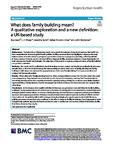What does family building mean? A qualitative exploration and a new definition: a UK-based study
| dc.contributor.author | Grace, B | |
| dc.contributor.author | SHAWE, JILL | |
| dc.contributor.author | Barrett, G | |
| dc.contributor.author | Usman, NO | |
| dc.contributor.author | Stephenson, J | |
| dc.date.accessioned | 2023-02-20T13:12:06Z | |
| dc.date.issued | 2022-10-28 | |
| dc.identifier.issn | 1742-4755 | |
| dc.identifier.issn | 1742-4755 | |
| dc.identifier.other | 203 | |
| dc.identifier.uri | http://hdl.handle.net/10026.1/20472 | |
| dc.description.abstract |
<jats:title>Abstract</jats:title><jats:sec> <jats:title>Background</jats:title> <jats:p>The importance of improving men’s and women’s knowledge of sexual and reproductive health has been emphasised in numerous global health policies. Fertility awareness literature highlights a disproportionately higher number of articles related to pregnancy-prevention compared to pregnancy-planning, which is justifiable in many contexts. However, recent concerted effort to improve fertility-awareness warrants a closer investigation of basic reproductive health terminologies. The objective of this study is to explore participants’ views of “family building” and provide a definition.</jats:p> </jats:sec><jats:sec> <jats:title>Methods</jats:title> <jats:p>We conducted 35 qualitative in-depth interviews on men, women and healthcare professionals who were sampled from a UK cross-sectional survey. We asked participants about terms such as ‘family planning’ and ‘family building’ to elicit views and explored the appropriateness of the term “family building.” Data were transcribed and analysed via Framework analysis. </jats:p> </jats:sec><jats:sec> <jats:title>Results</jats:title> <jats:p>When asked what ‘family planning’ meant to them, study participants stated that the term meant the avoidance of pregnancy. They viewed it as an “<jats:italic>umbrella term for the use of contraception methods,</jats:italic>” that “<jats:italic>paradoxically, the term family planning almost has a negative connotation regarding having a family</jats:italic>,” but could not state similar terminology for planning a family. Reasons cited for this perspective include the focus of school education and usage in clinical settings.</jats:p> </jats:sec><jats:sec> <jats:title>Conclusions</jats:title> <jats:p>In the absence of an explicit definition in literature, we generated a new definition for family building as follows: “<jats:italic>Family building refers to the construction or formation of a family, which can include steps or actions taken by an individual towards having children. In contrast to family planning, the intent focuses on pregnancy planning and childbearing rather than pregnancy prevention. However, it can also include actions taken to space the number of children one has.</jats:italic>” Some balance in the global public health messages, including bridging the gap in reproductive health literature, policies, processes and practices may contribute to the effort to improve fertility knowledge. Use of appropriate terminologies help optimise reproductive health services in order to enable men and women achieve their desired fertility intentions, whatever they may be.</jats:p> <jats:p><jats:italic>Trial registration</jats:italic> Not applicable</jats:p> </jats:sec> | |
| dc.format.extent | 203- | |
| dc.format.medium | Electronic | |
| dc.language | en | |
| dc.language.iso | eng | |
| dc.publisher | Springer Science and Business Media LLC | |
| dc.subject | Family planning | |
| dc.subject | Family building | |
| dc.subject | Fertility awareness | |
| dc.subject | Psychosocial | |
| dc.subject | Reproductive Health | |
| dc.subject | Qualitative research | |
| dc.subject | Childbearing | |
| dc.subject | Preconception health | |
| dc.subject | Reproductive intentions | |
| dc.subject | Fertility education | |
| dc.title | What does family building mean? A qualitative exploration and a new definition: a UK-based study | |
| dc.type | journal-article | |
| dc.type | Journal Article | |
| plymouth.author-url | https://www.webofscience.com/api/gateway?GWVersion=2&SrcApp=PARTNER_APP&SrcAuth=LinksAMR&KeyUT=WOS:000876307100001&DestLinkType=FullRecord&DestApp=ALL_WOS&UsrCustomerID=11bb513d99f797142bcfeffcc58ea008 | |
| plymouth.issue | 1 | |
| plymouth.volume | 19 | |
| plymouth.publication-status | Published online | |
| plymouth.journal | Reproductive Health | |
| dc.identifier.doi | 10.1186/s12978-022-01511-w | |
| plymouth.organisational-group | /Plymouth | |
| plymouth.organisational-group | /Plymouth/Faculty of Health | |
| plymouth.organisational-group | /Plymouth/Faculty of Health/School of Nursing and Midwifery | |
| plymouth.organisational-group | /Plymouth/REF 2021 Researchers by UoA | |
| plymouth.organisational-group | /Plymouth/REF 2021 Researchers by UoA/UoA03 Allied Health Professions, Dentistry, Nursing and Pharmacy | |
| plymouth.organisational-group | /Plymouth/Research Groups | |
| plymouth.organisational-group | /Plymouth/Research Groups/Institute of Health and Community | |
| plymouth.organisational-group | /Plymouth/Research Groups/Plymouth Institute of Health and Care Research (PIHR) | |
| plymouth.organisational-group | /Plymouth/Users by role | |
| plymouth.organisational-group | /Plymouth/Users by role/Academics | |
| dc.publisher.place | England | |
| dcterms.dateAccepted | 2022-10-08 | |
| dc.rights.embargodate | 2023-2-21 | |
| dc.identifier.eissn | 1742-4755 | |
| dc.rights.embargoperiod | Not known | |
| rioxxterms.versionofrecord | 10.1186/s12978-022-01511-w | |
| rioxxterms.licenseref.uri | http://www.rioxx.net/licenses/all-rights-reserved | |
| rioxxterms.licenseref.startdate | 2022-10-28 | |
| rioxxterms.type | Journal Article/Review |


